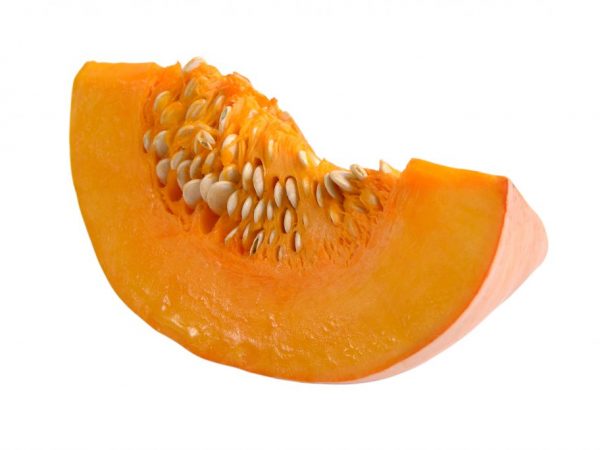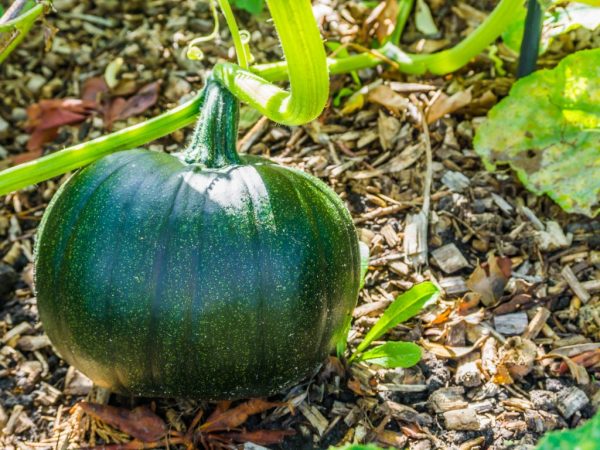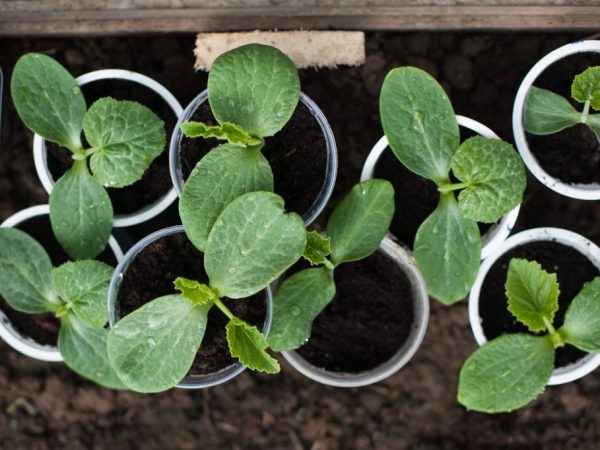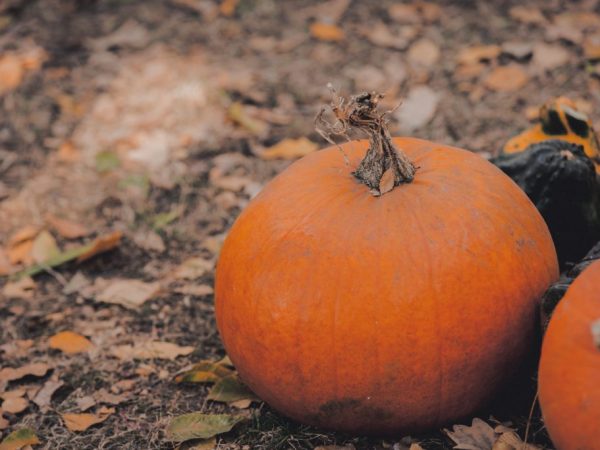The best pumpkin varieties for central Russia
Modern breeding has developed many pumpkin varieties for regions with variable weather. The pumpkin of central Russia is resistant to sudden changes in temperature, diseases and is highly productive. For planting in this area, experienced summer residents recommend using zoned varieties in order to get a bountiful harvest.

The best pumpkin varieties for central Russia
Sweet
There are several of the sweetest varieties that gardeners of central Russia prefer to cultivate.
- Chit. Small-fruited culture. Its description includes early maturity and good productivity. Vegetables are harvested after 3.5 months from the moment the first true leaves appear on the seedlings. The vegetable is rounded, ribbed, with a light gray skin. The average weight is 2-3 kg. The pulp is bright yellow in color, firm. Refers to varieties with good keeping quality - up to 4-5 months.
- Atlant. Pumpkins grow to gigantic size and weigh between 20 and 50 kg. Late ripening culture - fruits are harvested 4 months after sprouting. It has a dense and juicy flesh of bright orange color. The shape is spherical, slightly flattened.
- Big Max. A late ripening hybrid with good productivity. Suitable for growing using seedlings (seeds are sown at the beginning of April). Fruits are harvested 4 months after the appearance of the first cotyledons. The vegetables are large - the average weight of a pumpkin is 35-40 kg. The pulp is very sweet, juicy, orange in color.
- Almond. Subject to all the rules of agricultural technology, the plant gives a bountiful harvest. Pumpkins are medium in size, rounded. Their weight varies from 4 to 8 kg. The pulp is orange, firm. Fruits are stored for a long time without loss of taste and marketability - about 6-7 months.
- Donut. The variety is grown by the seedling method. It ripens in 3 months. The fruit is oval in shape with green veins and a creamy skin. Weight - 7-8 kg. The pulp is bright orange, juicy and very firm. This is one of the sweetest thin-crust varieties (sugar content - 10%).
- Sweet chamomile. The plant forms long lashes, after the appearance of 3-4 ovaries, it needs to be pinched. The fruit is small - the weight varies from 3 to 8 kg. The shape is spherical, the peel is orange, ribbed. Pumpkin is thin-barked with thick (about 10 cm), sweet and tasty orange-colored pulp. It is stored until spring and easily transfers transportation. The plant is cold and drought resistant, with balanced feeding, productivity increases.
- Chestnut f1. Hybrid form, suitable for growing through seedlings and further transplanting to the garden. An excellent variety for the Moscow region. The fruit is compact (weight - about 600 g), round shape, ribbed peel, two-color (pale orange with dark green spots).
- Honey dessert.Differs in increased sweetness, tart honey flavor and aroma. The pumpkin is flat-round, with a slight ribbing. The pulp is juicy, orange-colored. The weight is 6-12 kg. Technical maturity occurs in 90-100 days from the moment the shoots appear. If all the rules of agricultural technology are observed, the yield indicators increase and amount to 15-17 kg from a garden with an area of 1 m².
- Yellow centner. Belongs to the sweetest large-fruited varieties. Fruit weight reaches 50 kg, some specimens weigh up to 100-200 kg. 5-7 ovaries are formed on one plant. The pumpkin is round, slightly flattened, the peel and flesh of the same color are orange. The vegetable is stored from 4 to 6 months without loss of taste and presentation.
Early
For the Moscow region, early varieties are well suited, which ripen before the onset of the first cold weather.
Healing
It is a drought and cold tolerant crop. Fruits are harvested 3 months after germination. Forms small lashes, so it does not take up much space on the site.
The fruit is spherical, weighs 2.5-3 kg. The peel is orange. The pulp is juicy, firm, of medium thickness. The variety is stable - the shelf life of the fruits is about 6 months.
Volzhskaya gray
Vegetable crop with high productivity. She gives a crop 3 months after transplanting seedlings to the site. The peel is light gray with a greenish tint. The shape is spherical, slightly flattened.
The pulp is sweet and firm. The advantages of the variety include high resistance to white rot and good keeping quality - the fruits are stored for more than six months.
Curative
A productive variety with a ripening period of vegetables up to 3 months. The body is average. Fruits are small - 3-5 kg in weight. It is a thin-baked variety with juicy and crispy flesh. It is stored for more than six months, while it does not lose its taste and presentation.
The vegetable is rounded, flattened, with an orange ribbed peel. The aroma is pronounced.
Sweet pie

Pumpkins are very sweet and juicy
Possesses good productivity. Early ripening vegetables are harvested 3 months after the appearance of the cotyledons.
Pumpkins are even, smooth, fiery in color. The average weight is 2-3 kg. The pulp is sweet, juicy and firm.
Candied fruit
Produces delicious and sweet fruits in abundance. Vegetables ripen together in 3 months after germination. Fruit weight is average - 4-5 kg. The pulp is firm, yellow-orange. The shape of the pumpkin is round, flattened.
Bush
The varieties of this group are excellent for small areas, because do not form large lashes and do not take up much space in the garden.
Freckle
Cold-resistant, ultra-early ripening culture - the fruits are harvested 80 days after germination. Differs in marble leaves, dark green spots on the orange peel.
The plant forms 5-6 ovaries. Small vegetables - 2-3 kg, sweet, crunchy. Maturation is amicable.
Gribovskaya bush 189
The hybrid yields a harvest 3 months after germination. Bushes are compact in size.
Pumpkins of medium weight - from 2 to 5 kg, ovoid, with a yellow skin with dark green stripes. The taste is sweet, the flesh is firm and crunchy. The harvest is stored until the beginning of winter.
Dachnaya
Another unique bush variety that gives an early harvest of vegetables - 90 days after the appearance of the first cotyledonous leaves. The fruits are oval in shape, with a smooth yellow skin and dense lemon-colored flesh. The taste is sweet with a light vanilla aroma. Shelf life is 4 months.
Late
Late ripening varieties have a long shelf life and good yields.
Gribovskaya winter
This culture ripens 4 months after transplanting seedlings to the garden. The vegetables are flattened, gray, weight - 3-4 kg.
The pulp is firm, orange in color, contains a large amount of nutrients. The crop is perfectly stored in a cool, dry place.
Premiere
The plant forms long stems, therefore it requires a lot of space on the site. Vegetables ripen in 4 months from the moment of germination. Pumpkins are flattened.The peel is dark green, covered with pale yellow spots. The pulp is orange, of medium thickness (4-5 cm).
On one bush, 2-3 fruits are formed, the weight of which reaches 5-6 kg. The shelf life of vegetables is about six months.
Secrets of Successful Growing

Pumpkins are unpretentious in care
The successful cultivation of pumpkin in central Russia depends on compliance with the rules of agricultural technology, because the weather in this area is changeable and it is not always possible to get a good harvest. In one small garden bed, you can grow many fruits, which will be enough for the whole winter.
Timing
You can plant pumpkin seeds right in the garden, but it is better to first grow the seedlings, and then transplant them to the site. As practice shows, the bushes are stronger and give a good harvest. The optimal dates for sowing seeds are the last days of March or the first ten days of April.
Seeds
To get strong seedlings, you need to collect seeds from last summer's harvest. They are rejected - they choose medium-sized specimens with a flat and smooth surface, without black and yellow spots, as well as mold.
Purchased seeds do not need prophylactic treatment for diseases, and homemade seeds need to be pickled. To do this, they are placed in a weak solution of potassium permanganate for 30 minutes. Then they are removed and filled with warm water (50-55 ° C). The seeds are kept in it for 3 hours.
To increase the percentage of germination of planting material, ash can be added to the water - 1 tsp. - either one of the growth stimulants ("Epin", "Kornevin" or "Heteroauxin").
Before planting the seeds, they are slightly dried so that their surface is not slippery.
Landing capacity
You can grow pumpkin seedlings in any capacious container with drainage holes. Many gardeners choose to sow seeds in peat or cardboard disposable pots. Do not plant their boxes or containers, because this culture does not tolerate picking (after planting it may die).
Priming
To grow strong shrubs with good foliage and a thick stem, you need to use quality soil. You can choose one of two soil mixture options:
- purchased substrate for growing seedlings of vegetable crops;
- prepared independently from rotted sawdust (1 part), peat (2 parts), humus (1 part) and nitrophoska (1 tsp per 1 kg of soil).
Scheme
With a single planting, the containers are filled with soil mixture, leaving a little space on top, make a small depression (1 cm), put seeds in it and sprinkle it with earth, irrigate with a spray bottle and cover with transparent glass or film.
Before the emergence of shoots, regular irrigation and airing are carried out (every 2 days). Crops are provided with a stable temperature in the range of 20-23 ° C, lighting (diffused daylight for at least 5 hours a day).
A week after the shoots break through, they remove the shelter, fertilize the seedlings with nitrophos. Dissolve 1 tsp in 10 liters of water. substances.
Transplant rules

We transplant strong seedlings into warm ground
You can transplant seedlings to the garden bed when it grows to 15-20 cm and forms 4-5 leaves. Usually this procedure is carried out in mid or late May, when it becomes warm outside and the soil warms up to 10-12 ° C.
The soil
It is necessary to plant pumpkins on the southern side of the site, where there are no strong winds and the sun always shines, which is necessary for this light-loving culture. For climbing varieties, a site near a fence or arch is suitable. The best “predecessors” of pumpkin are legumes, cabbage, root vegetables, onions and garlic.
This plant is demanding on soil fertility and loves light and loose soils.
You can improve the properties of clay or sandy soil by adding compost (1: 1) to it. Peat or river coarse sand is also added. These components increase the moisture and air permeability of the soil mixture. Consumption - 10 kg per 1 m².
2 weeks before the planned planting, loam is sprinkled with nutritious compositions: ash (250 g), superphosphate (20 g), potassium and ammonium nitrate (10 g each).
To increase the nutritional value of sandy loam, you will need:
- humus - 5 kg;
- superphosphate - 40 g;
- ash - 0.5 kg.
The quantity is calculated for an area of 1 m². After fertilization, the site is dug up and leveled.
Landing scheme
Dig holes at a distance of 80-90 cm from each other, with a distance between rows of 1 m. The depth of the holes should correspond to the size of the root system of the seedlings. Each is watered with water - 1 liter, then the roots are dipped into it, sprinkled with earth and spud. When planting seeds in open ground, 4x4 cm pits are made. The optimal time for this is the end of May or the beginning of June.
Care

Great yield when grown properly
To grow healthy and strong bushes with abundant fruiting, you will need to provide them with proper and timely care.
- Watering should be regular, moderate and carried out only after the top layer of the earth has dried. The frequency and extent of this procedure depends on the weather. Water is poured under the root so that it does not get on the stems and leaves, otherwise they will get sunburn. Watering the beds is necessary in the evening or morning hours, when the sun is not so active.
- After watering, the bed is loosened to improve its moisture and air permeability. Weeds are also removed.
- Successful cultivation depends on the quality and quantity of fertilization. The first time it is carried out 10 days after transplanting seedlings. During this period, liquid mullein will be the best fertilizer. 1 liter of the substance is dissolved in a bucket of water. A week before flowering and 10 days after it, a complex composition is used: 3-5 g of ammonium nitrate, 6-8 g of superphosphate and 3-5 g of potassium salt. The dry mixture is diluted in a bucket of water. To attract bees at the beginning of blooming, the bushes are irrigated with honey solution (1 tablespoon per 1 liter of water). Processing is carried out early in the morning.
- The rationing of the ovaries is necessary to obtain large and tasty fruits - no more than 3 pumpkins are left on one lash, the rest are removed. For climbing varieties, they create a support - stakes or trellises.
Diseases
It is difficult to grow pumpkin in the open field and get high-quality fruits without preventive treatments. At all stages of development, bushes can be affected by various diseases.
- Bacteriosis Signs - the appearance of numerous brown sores on the surface of the leaf plate and stems, which leads to the further death of the bush.
- White rot. Fungal infection manifests itself as white spots on foliage and shoots. The affected areas rot and the spots turn brown over time.
- Root rot. The surrounding brown blotches are formed mainly on the stems and roots. Infected bushes stop growing, foliage turns yellow and crumbles.
- Powdery mildew. A symptom of the disease is the appearance of a whitish coating on all aboveground organs of the culture, which eventually becomes wet. The affected areas begin to rot.
- Anthracnose. The leaves are covered with numerous black sores.
You can grow a pumpkin in the same place with an interval of 3 years. You also need to plant a high-quality seed disinfected with a solution of potassium permanganate.
If the culture is damaged by diseases, it is necessary to remove the damaged areas and treat with a solution of copper sulfate or Bordeaux liquid of 1% concentration.
Pests
Of the pests, pumpkin is annoyed by spider mites, sprout flies, and aphids. Sap-sucking parasites inhibit the growth of the aerial part, reduce the quality of flowering and fruiting. With a strong infection, the bushes die.
For prevention, plants with a strong odor should be planted between the rows - mint, garlic, onions or tansy. It is also necessary to avoid thickening of the plantings, remove leaves in the lower part in time, sprinkle the aisles with ash.
To combat parasites, use "Decis", "Aktellik", "Aktara" or "Karbofos".
Harvesting and storage
Depending on the variety, the collection of fruits is carried out at different times. In ripe vegetables, the stalk is lignified, dry and tough. The skin of the pumpkin should be firm and rich in color.Bushes with ripe fruits turn yellow and dry out.
Pumpkins are removed from the garden before the onset of the first frost, because the slightest freezing of the crop will negatively affect the storage duration.
In the Moscow region, vegetables can be removed in early September to allow the fruits to ripen at home for about 2-3 weeks. They are removed in dry weather so that moisture does not accumulate on their surface, which can cause rotting.
Store vegetables in a dry and well-ventilated place. The optimum temperature is 1-3 ° C, humidity is 55-60%.

